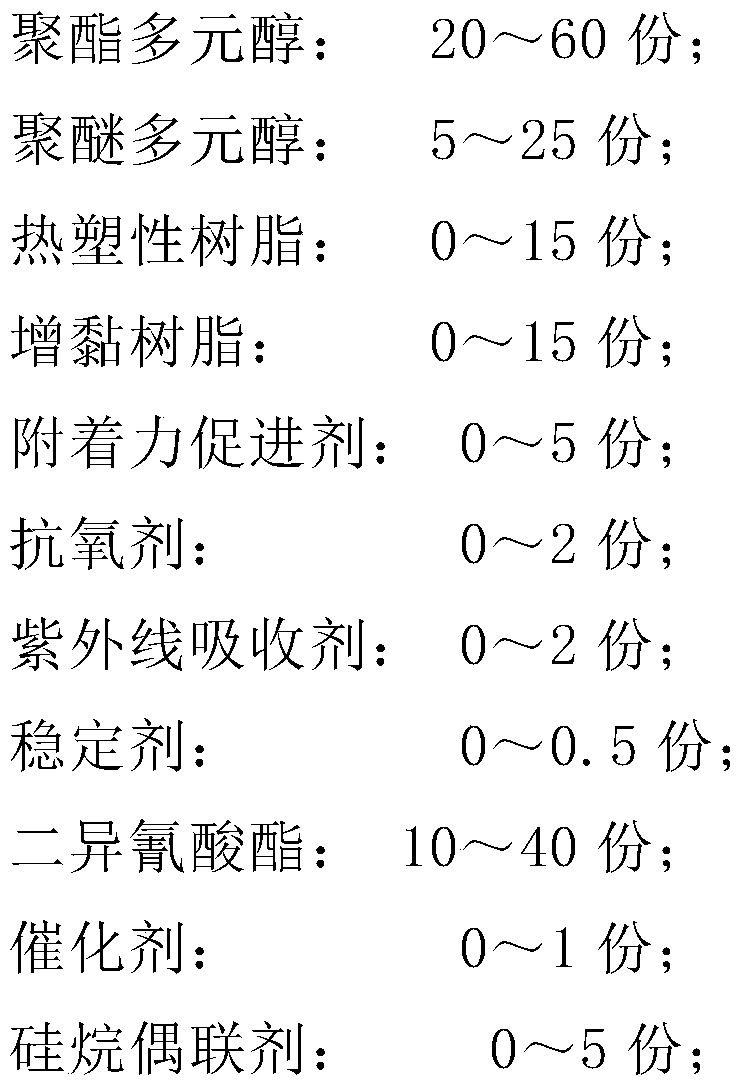Reactive polyurethane hot melt adhesive for sealing household appliances, and preparation method thereof
A polyurethane hot-melt adhesive and sealing technology, which is applied in the direction of polyurea/polyurethane adhesive, adhesive, epoxy resin glue, etc., can solve the problem of low assembly efficiency and achieve the effect of improving assembly efficiency
- Summary
- Abstract
- Description
- Claims
- Application Information
AI Technical Summary
Problems solved by technology
Method used
Image
Examples
Embodiment 1
[0048] The preparation method of the home appliance sealing reactive polyurethane hot melt adhesive of this embodiment, its steps are as follows:
[0049] 1) Get 15 parts by weight of amorphous polyester polyol, 30 parts by weight of crystalline polyester polyol, 20 parts by weight of polyether polyol, 7 parts by weight of thermoplastic resin, 2 parts by weight of adhesion promoter, 0.1 Add the antioxidant in parts by weight, the ultraviolet absorber in 0.1 parts by weight, and the stabilizer in 0.05 parts by weight into the reaction kettle, and vacuum dehydrate under the condition of 100-130 ° C for 60 minutes;
[0050] 2) Cool down to 90°C, and add 25 parts by weight of diisocyanate while stirring;
[0051] 3) Slowly heat up to 100-120°C, vacuum defoaming reaction for 60 minutes;
[0052] 4) Cool down to 100°C, add 0.05 parts by weight of catalyst and 0.7 parts by weight of silane coupling agent, then heat up, vacuumize at 100-130°C until no bubbles appear, and test viscosity...
Embodiment 2
[0066] The preparation method of the home appliance sealing reactive polyurethane hot melt adhesive of this embodiment, its steps are as follows:
[0067] 1) Get 25 parts by weight of amorphous polyester polyol, 30 parts by weight of crystalline polyester polyol, polyether polyol of 15 parts by weight, tackifying resin of 6 parts by weight, adhesion promoter of 2 parts by weight, Add 0.1 parts by weight of antioxidant, 0.1 parts by weight of ultraviolet absorber, and 0.05 parts by weight of stabilizer into the reaction kettle, and vacuum dehydrate at 100-130 °C for 60 minutes;
[0068] 2) Cool down to 85°C, and add 21 parts by weight of isocyanate while stirring;
[0069] 3) Slowly heat up to 100-130°C, vacuum defoaming reaction for 60 minutes;
[0070] 4) Cool down to 110°C, add 0.05 parts by weight of catalyst and 0.7 parts by weight of silane coupling agent, then heat up, vacuumize at 100-130°C until no bubbles appear, and test viscosity and NCO%;
[0071] 5) After the vi...
Embodiment 3
[0087] 1) Get 10 parts by weight of amorphous polyester polyol, 20 parts by weight of crystalline polyester polyol, 25 parts by weight of polyether polyol, 20 parts by weight of thermoplastic resin, 5 parts by weight of tackifying resin, 0.1 parts by weight Part of antioxidant, 0.1 part by weight of ultraviolet absorber, 0.05 part by weight of stabilizer are added to the reactor, and vacuum dehydration is carried out at 110-130°C for 60 minutes;
[0088] 2) Cool down to 80°C, and add 18 parts by weight of isocyanate while stirring;
[0089] 3) Slowly heat up to 100-130°C, vacuum defoaming reaction for 60 minutes;
[0090] 4) Cool down to 90°C, add 0.05 parts by weight of catalyst and 1.7 parts by weight of silane coupling agent, then heat up, vacuumize at 100-130°C until no bubbles appear, and test viscosity and NCO%;
[0091] 5) After the viscosity and NCO% are qualified, the material is discharged, sealed, and packaged to obtain the product.
[0092] The amorphous polyeste...
PUM
| Property | Measurement | Unit |
|---|---|---|
| viscosity | aaaaa | aaaaa |
Abstract
Description
Claims
Application Information
 Login to View More
Login to View More - R&D
- Intellectual Property
- Life Sciences
- Materials
- Tech Scout
- Unparalleled Data Quality
- Higher Quality Content
- 60% Fewer Hallucinations
Browse by: Latest US Patents, China's latest patents, Technical Efficacy Thesaurus, Application Domain, Technology Topic, Popular Technical Reports.
© 2025 PatSnap. All rights reserved.Legal|Privacy policy|Modern Slavery Act Transparency Statement|Sitemap|About US| Contact US: help@patsnap.com



